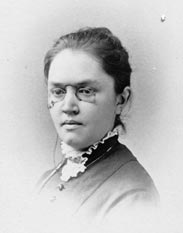Falmouth, Massachusetts. Statue of poet and professor Katherine Lee Bates, Lloyd Lillie, Sculptor (1986). Photo: Samuel D. Gruber 2014.
Falmouth,
Massachusetts. Statue of poet and professor Katherine Lee Bates, Lloyd
Lillie, Sculptor (1986). Photo: Samuel D. Gruber 2014.

Katherine Lee Bates, trying to look stern. photo: Wikipedia
Katherine Anne Bates in Falmouth, Massachusetts
by Samuel D. Gruber
A favorite sub-category of public monuments previously mentioned is that of poet-philosopher-sage-scholar, exemplified by Andrew Dickson White's seated statue at Cornell. A potential sub-sub-category is that of college professor. How many of them (us) are commemorated in stone and bronze, and how and why?
Well, the Cape Cod town of Falmouth, Massachusetts makes a big deal out of Wellesley College English Professor Katherine Lee Bates (1859 – 1929), who was born here, had a hard early life, before eventually gaining success as a teacher and everlasting fame as author of the words to the anthem "America the Beautiful." The house where Bates was born is an historic site, and there is a statue of her prominently placed in the public park in from of the Memorial Library on Main Street, a park that also serves to honor the town's military dead.
Falmouth,
Massachusetts. Statue of poet and professor Katherine Lee Bates, Lloyd
Lillie, Sculptor (1986). Photo: Samuel D. Gruber 2014.
The life-size bronze statue by sculptor Lloyd Lillie, was inaugurated in 1986. Bates is shown (if indeed she looked like this) as the inspired young poet, gazing from the summit of Pike's Peak in Colorado in 1893. Bates originally wrote the words as a poem, Pikes Peak, first published in the July 4, 1895 issue of The Congregationalist, where it was titled America. Amended versions were published in 1904 and 1913. Check out the original and amended versions.
The sculptor, like many before him, strives to give dramatic form to the life of the mind.
Bates's life in Falmouth was not an easy one. She was the daughter of Congregational pastor William Bates and his wife, Cornelia Frances Lee. Her father died the year after being named to Falmouth's First Congregational Church, shortly after Katherine's birth. The "widow Bates" and her four children were impoverished and moved five times during the next twelve years before leaving Falmouth for good, moving to Wellesley Hills.
Falmouth, Massachusetts. 16 West Main St. Birthplace of Katherine Lee Bates.
Bates graduated in Wellesley College's second class, and returned to teach there for 40 years. A college dormitory is named in her honor. Unfortunately, its banal design is not nearly as inspired as her famous poem. She found success as a writer and teacher in Wellesley, where she rose to the position of full professor, and as a prolific writer and editor, published more than 40 books of poetry, travel literature, and criticism (for a list of these see the well-presented Wikipedia entry)
In Falmouth, where Bates returned to visit every year, and where she is buried, plaques inside Falmouth's Memorial Library, and at the statue commemorate her authorship of "America the Beautiful," her best known work. But neither plaque mentions her long (presumed lesbian) 'Boston marriage" relationship with Wellesley College historian and economic professor Katharine Coman with whom she lived for 25 years, until Conan's death in 1915.
Today, this aspect of her personal life sometime outshines her professional accomplishments. In 2012 Bates was named one of the 31 LGBT history "icons" by the organizers of LGBT History Month. The women's relationship is explored by Judith Schwarz, in "Yellow Clover: Katharine Lee Bates and Katharine Coman," Frontiers: A Journal of Women's Studies, 4:1 (Spring 1979), 59–67. I wonder how many American right-wingers know one of their favorite songs was penned by a lesbian. But why not? And don't forget the equally patriotic, but much less poetic "God Bless America" was written in 1918 by Irving Berlin - a Jewish immigrant.






Thanks for sharing this sites!
ReplyDeleteNameplate Plaque
Historical Marker